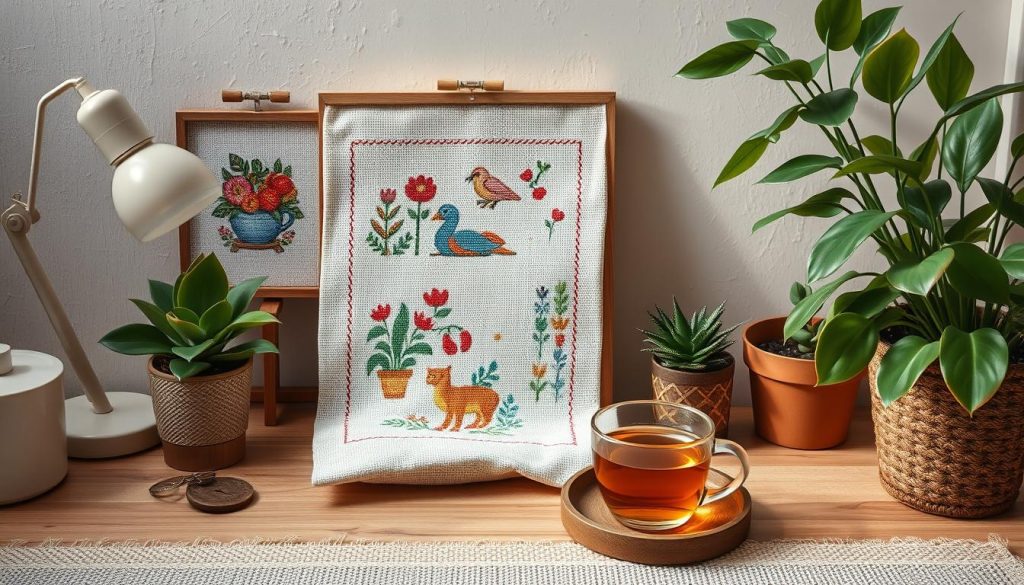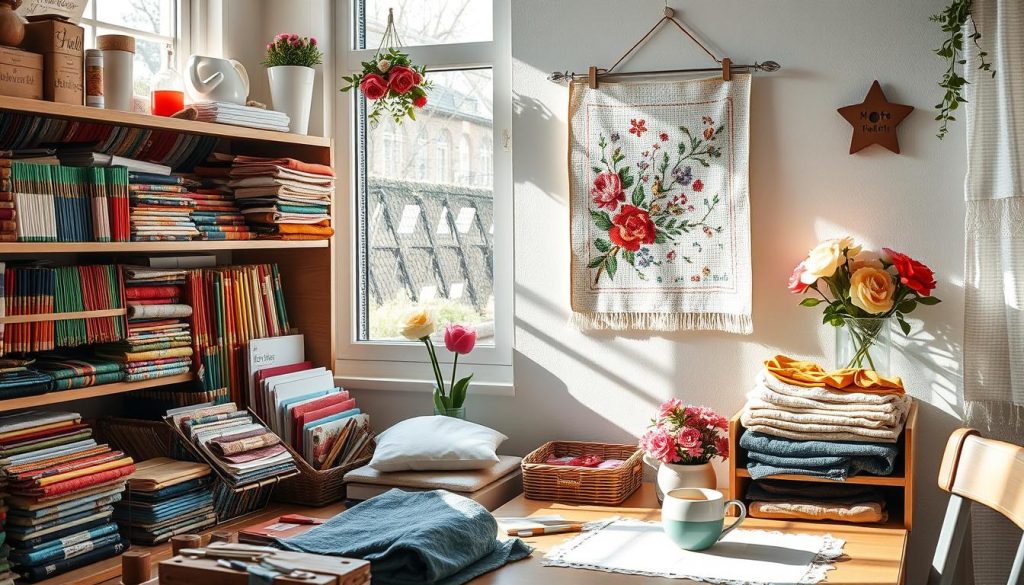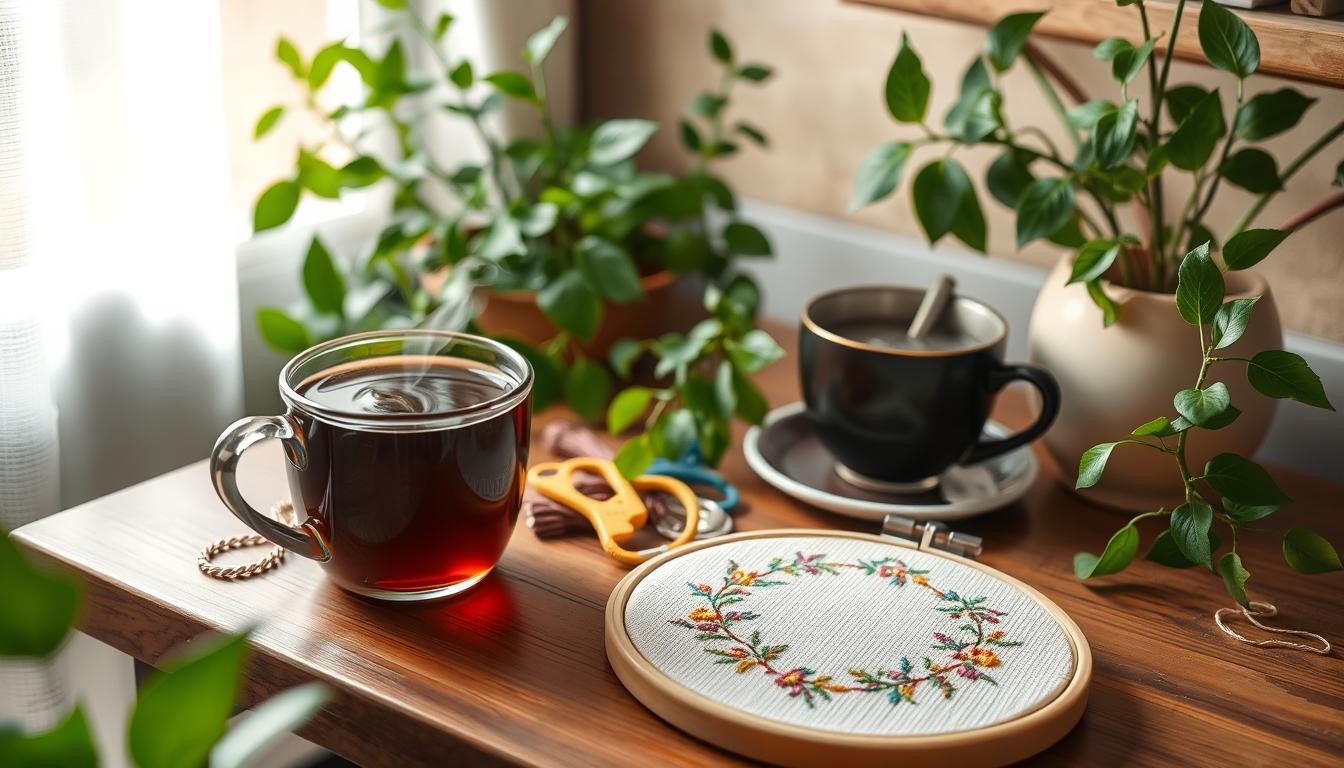Cross stitching is more than just a hobby; it’s a mental health booster. Many people use it to handle anxiety and depression. The repetitive motions help you focus and calm your mind.
Studies show that crafting, like cross stitching, reduces anxiety and stress. It also lowers heart rates and cortisol levels. This makes it a great way to relax and feel better.
Psychiatric experts often suggest activities like cross stitching for mental health. McFly drummer Harry Judd found it helped him with anxiety. Others, like Debbie Weaver and Shelly Witham, say it relieves stress and helps with chronic pain.
Key Takeaways
- Cross stitching can significantly reduce anxiety and stress.
- Engaging in repetitive motions during crafting promotes a meditative state.
- Therapeutic cross stitch acts as a grounding technique for managing negative thoughts.
- Mindfulness cross stitch helps lower heart rates and cortisol levels.
- Public figures have shared positive experiences of using cross stitch to cope with mental health challenges.
The Calming Effects of Cross Stitching
Cross stitch is more than a hobby; it’s a way to improve your mental health. It offers a meditative experience that can greatly benefit your mental wellbeing. This craft helps reduce stress and anxiety.
Inner Peace Through Repetition
The repetitive motion of cross stitch calms the mind. It helps clear thoughts and brings inner peace. Many find it a great way to unwind after a long day or hours of computer work.
Flow State and Mindfulness
Getting lost in cross stitch can put you in a ‘flow’ state. This state of complete focus offers a mental break from daily stress. It allows you to fully immerse yourself in the craft, whether following a pattern or creating your own.
Grounding Techniques for Anxiety
Cross stitching can be a powerful tool for managing anxiety. It keeps your mind focused on the task, helping to reduce anxiety. Mental health experts often recommend crafting as a way to keep the mind busy and away from worries.
It’s not just for adults; cross stitching is great for kids too. It improves counting, pattern-following, and creativity. It also helps build community and offers a break from screens, promoting a sense of pride and accomplishment.
The Therapeutic Benefits of Cross Stitch
Cross stitching is great for those looking for emotional and psychological relief. It lets you channel your energy into something creative. This can be very empowering, especially when life feels overwhelming.
When you stitch, you control both the action and the outcome. This leads to a sense of achievement and emotional uplift. It’s a way to feel more in control.
Cross stitch also helps lower cortisol levels, the body’s stress hormone. This leads to a calm and well-being feeling. It’s especially good for emotional therapy, as it reduces anxiety and strengthens brain connections.

Stitching releases happy chemicals like serotonin and dopamine. This makes you feel happier and more well. Creating something tangible is very satisfying, boosting your self-belief and mood.
Studies show that cross stitching can make you feel more positive and confident. It’s a great way to express yourself creatively. This aligns with research from the Journal of Positive Psychology.
Cross stitching is also a grounding technique during big life changes. It helps you stay calm and focused. A study in the British Journal of Occupational Therapy found that 81% of participants felt calm and happy after knitting.
Cross stitching is good for your mind and body. It can lower blood pressure and heart rates. It keeps your mind sharp and can even help prevent dementia, according to the Alzheimer’s Association.
In summary, cross stitching offers many benefits. It reduces stress, boosts mood, and improves cognitive function. It’s a valuable tool for mental health in today’s fast-paced world.
Cross Stitching as a Form of Mindful Meditation
Practicing cross stitch can greatly improve your mental health. It involves repetitive actions that help you stay present. This focus on each stitch builds a sense of pride and accomplishment.
The Science Behind Mindfulness and Crafting
Studies show that cross stitching is a form of mindfulness. It requires focused attention, much like meditation. This can lower stress and improve mental clarity.
Listening to “Untangled” for free meditations can enhance your cross stitching experience.
Mind-Body Connection
Doing cross stitch strengthens the mind-body connection. Choosing colors and designs can express your emotions. Jen Sincero’s “You Are a Badass at Making Money” highlights the joy in simple tasks.
Personal Stories of Transformation
Many people have found peace through cross stitching. It helps manage stress and boosts focus. “The Creative Habit” suggests embracing imperfections, a common experience among cross stitch fans.
Even a few minutes of cross stitch can be a mental reset. Joining cross stitch communities adds support and a sense of belonging.
Adding cross stitch to your routine can greatly improve your mental health. It combines creativity with mindfulness, promoting emotional strength and personal growth.
How Cross Stitch Fosters a Sense of Accomplishment
Doing cross stitch can really boost your mental health by making you feel accomplished. Finishing a project, big or small, gives you a deep sense of pride. This is especially true when you face tough days.
Every stitch adds to a stunning piece, improving your skills. This careful work requires focus and detail, which helps you relax and think clearer. It also makes your hands and eyes work better together.
Seeing your work come to life is incredibly fulfilling. It shows you the value of your effort. This feeling of pride grows when you see your hard work turn into something beautiful.
For many, cross stitching is more than a hobby. It’s a source of inspiration and motivation. It helps those with mental health issues like depression feel stronger and more confident.
It’s not just about making something; it’s about the joy it brings. Sharing your creations with others adds to your sense of pride. It makes you feel good about yourself and your accomplishments.
Stitching is a journey that heals your mind and heart. Every finished piece is a victory. It shows you can create and change things, boosting your self-confidence and happiness.
Social Connection Through Cross Stitch Communities
Cross stitch communities are more than just places for craft lovers. They are key social networks that help people connect through stitching. These groups offer a sense of belonging and support, whether online or in person.
Online Cross Stitch Forums and Groups
The internet has changed how we connect through stitching. Online platforms offer patterns and workshops, making it easy for stitchers worldwide to share. The Threads of Diaspora project is a great example, creating a Tatreez quilt with help from many countries.
Local Cross Stitch Events and Retreats
Local events are perfect for those who love meeting people. The Puerto Rican Embroidery Squadron has over 60 members who stitch together. Events like the Stitching Social, with about 12 people, offer a close experience.
Participants get full kits and enjoy themed events. This makes the experience even better through community involvement.
Shared Projects and Collaborative Stitching
Collaborative projects are great for building community. They bring people together, creating a sense of teamwork. The Threads of Diaspora project is a great example, meeting and then doubling its goal.
Joining in on these projects, attending events, or online forums can boost your well-being. You’ll become part of a supportive and lively cross stitch community.
Cross Stitch Supplies and Getting Started
Starting your cross stitch journey can be fun and rewarding. It’s important to pick the right supplies for a smooth start, especially for beginners. Here’s how to begin with confidence:
Choosing the Right Cross Stitch Kits
Choosing the right cross stitch kits is key to a great stitching experience. Beginners should look for kits with everything needed, like Aida fabric, thread, needles, and a pattern. Aida fabric is great for beginners—6 count for kids or 14 count for adults because it’s easy to count.
DMC’s Egyptian cotton thread is a top choice for any project. It’s high-quality and durable.

Start with simple patterns that have color guides to help you. Use embroidery hoops from 4” to 19” to keep the fabric tight. This makes stitching smoother.
Beginner Tips for Cross Stitch
For beginners, picking the right supplies and learning basic techniques is crucial. Here are some tips to help you start right:
- Start with small projects to build your confidence and skill.
- Use a blunt-ended tapestry needle for easy threading and to protect the fabric.
- Cut your embroidery floss into 18-inch lengths to avoid twisting and knots.
- Usually, use one or two strands of floss for each stitch.
- Avoid knots; secure the thread by weaving it under existing stitches for a smooth back.
- Secure threads well at the end of a stitch to prevent unraveling.
Following these tips will make starting cross stitching more fun and less stressful.
Advanced Cross Stitch Techniques
Once you’re comfortable with the basics, you can explore more advanced techniques. These can make your projects look more sophisticated. Here are some tips to take your craft to the next level:
- Try different stitches like French knots and backstitches for more detail and texture.
- Use different fabrics like linen for a finer finish.
- Learn to blend threads for gradient effects and smoother color changes.
- Try specialty stitches for a unique touch in your designs.
- Work on bigger, more complex patterns to challenge yourself and boost your creativity.
By improving your cross stitch skills, you can turn simple designs into beautiful works of art. This shows off your technical skill and creativity.
Here’s a quick comparison of some essential supplies for beginners and advanced stitchers:
| Supply | Beginners | Advanced |
|---|---|---|
| Fabric | Aida (6 count for children, 14 count for adults) | Linen or higher count Aida |
| Thread | DMC Egyptian cotton | Blended threads for gradients |
| Needles | Tapestry needles with blunt ends | Specialty needles for detailed work |
| Hoops | 4” to 19” embroidery hoops | Q-snaps or frames for large projects |
Conclusion
Cross stitching is more than a hobby; it’s a way to improve your mental health. It offers many benefits, like calming effects and the joy of meditation. It helps you stay mindful and connect with others in a special way.
Every project you finish is a big achievement. Learning the basics and trying new techniques makes your journey more rewarding. The calm and focus you get from stitching help you feel better overall.
Begin with simple supplies like Aida fabric, DMC floss, and good needles. This keeps costs down and helps you learn. As you get better, you can try fancier materials and patterns. This makes your projects even more special and supports your mental health.
Your cross stitch journey is personal and fulfilling. It’s about creating art and improving your mental health. Whether you’re new or experienced, every stitch you make is meaningful. Let cross stitch bring you peace, joy, and a sense of accomplishment.
